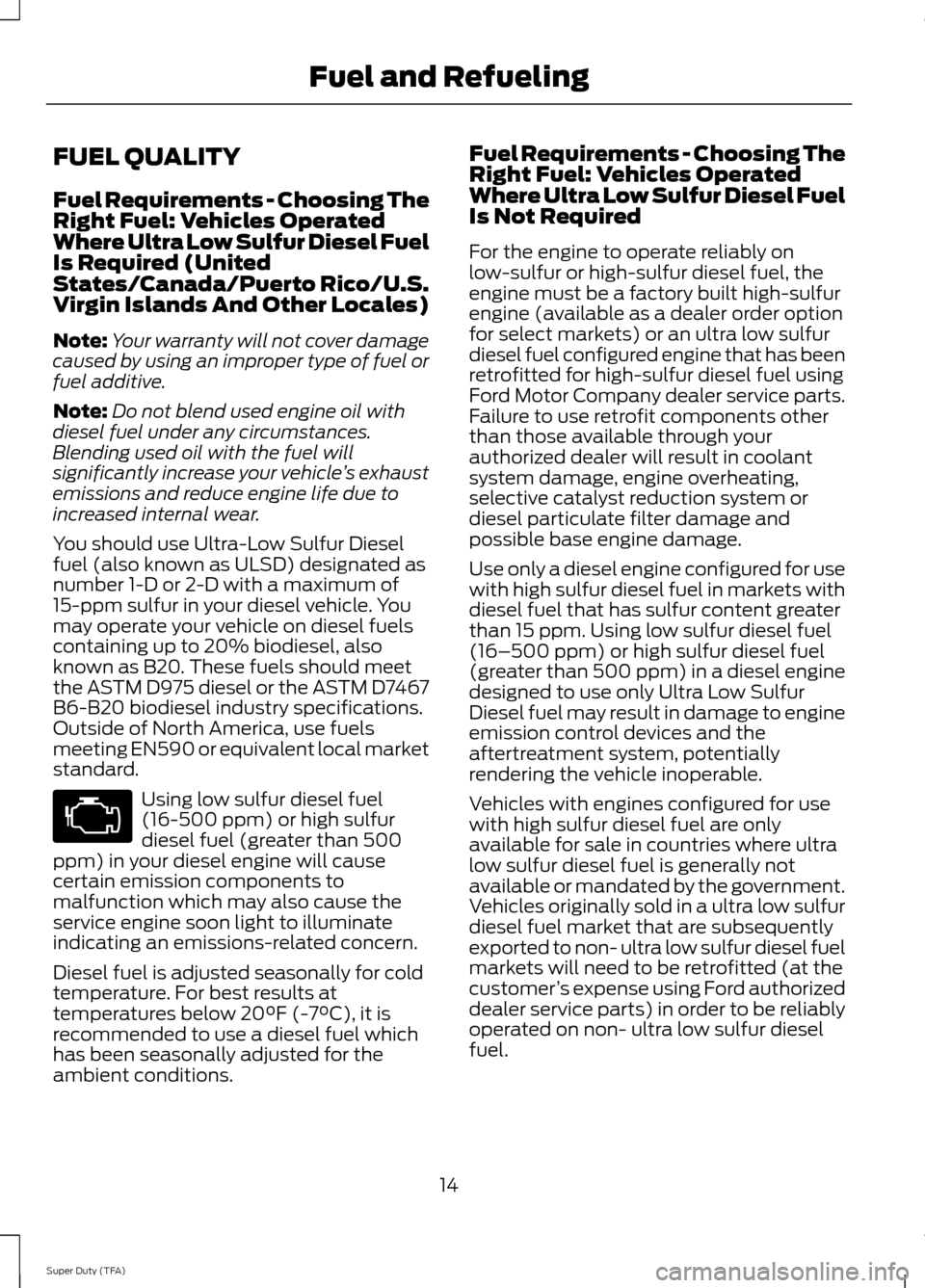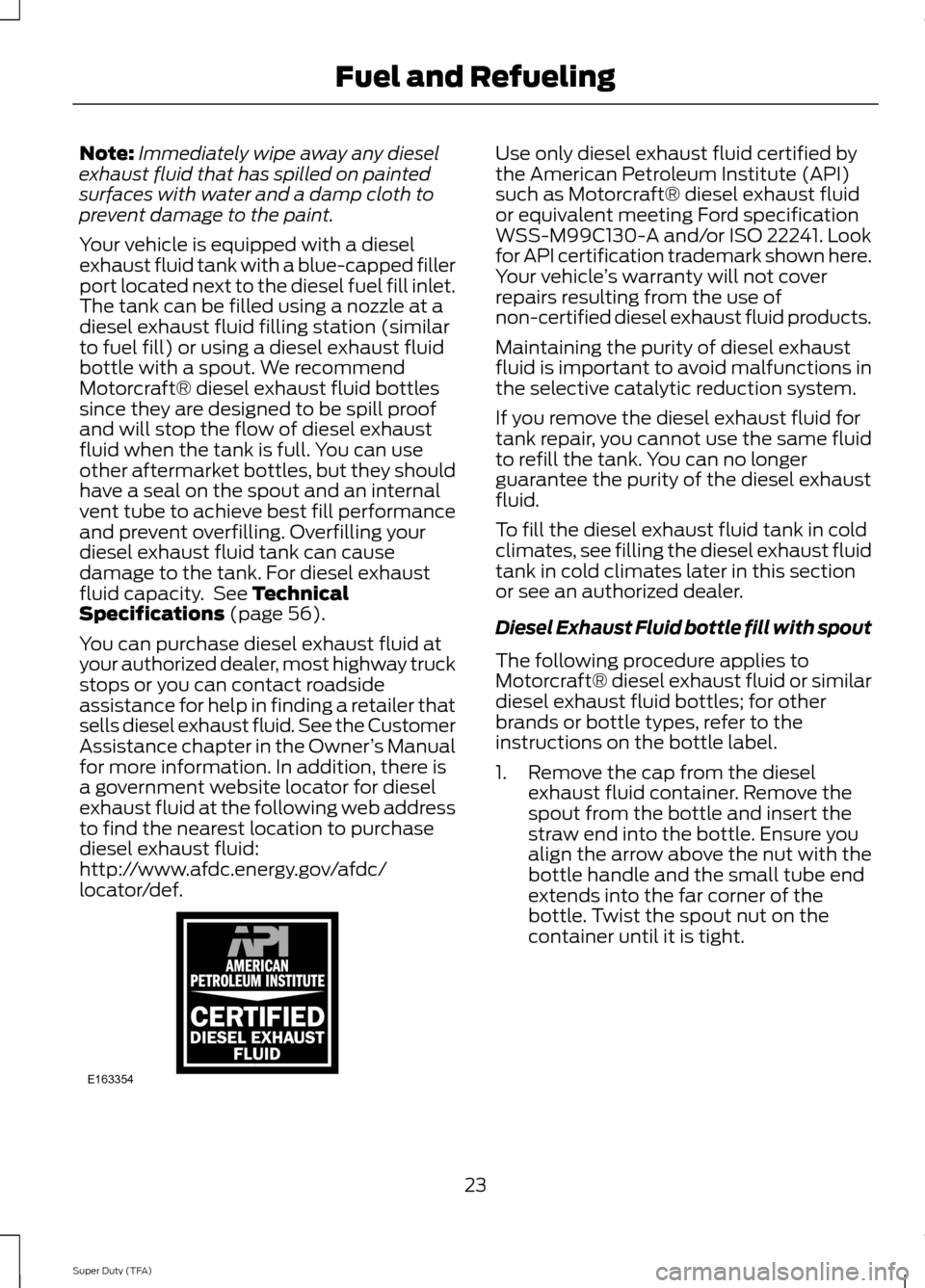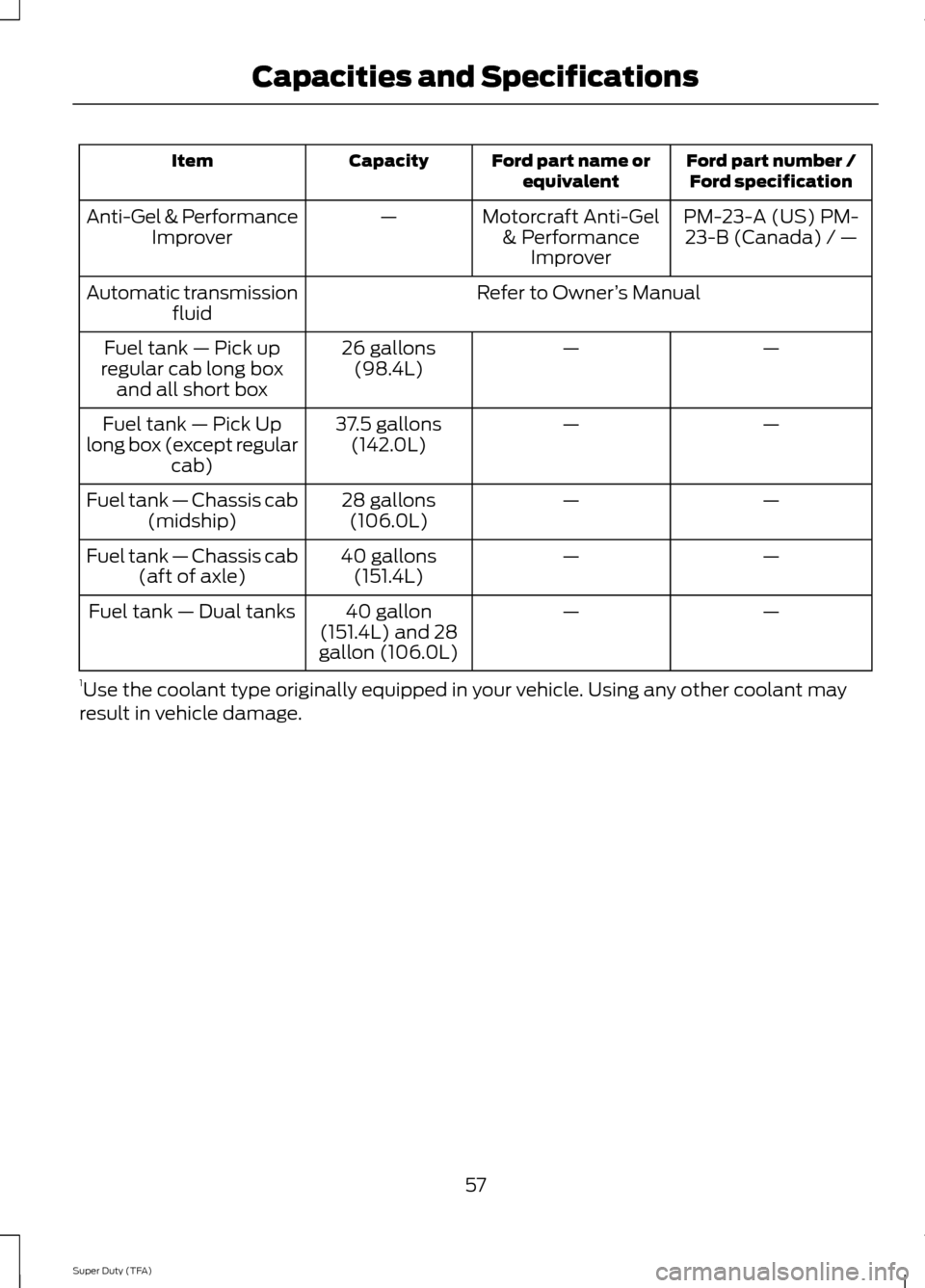2014 FORD SUPER DUTY fuel type
[x] Cancel search: fuel typePage 17 of 82

FUEL QUALITY
Fuel Requirements - Choosing The
Right Fuel: Vehicles Operated
Where Ultra Low Sulfur Diesel Fuel
Is Required (United
States/Canada/Puerto Rico/U.S.
Virgin Islands And Other Locales)
Note:
Your warranty will not cover damage
caused by using an improper type of fuel or
fuel additive.
Note: Do not blend used engine oil with
diesel fuel under any circumstances.
Blending used oil with the fuel will
significantly increase your vehicle ’s exhaust
emissions and reduce engine life due to
increased internal wear.
You should use Ultra-Low Sulfur Diesel
fuel (also known as ULSD) designated as
number 1-D or 2-D with a maximum of
15-ppm sulfur in your diesel vehicle. You
may operate your vehicle on diesel fuels
containing up to 20% biodiesel, also
known as B20. These fuels should meet
the ASTM D975 diesel or the ASTM D7467
B6-B20 biodiesel industry specifications.
Outside of North America, use fuels
meeting EN590 or equivalent local market
standard. Using low sulfur diesel fuel
(16-500 ppm) or high sulfur
diesel fuel (greater than 500
ppm) in your diesel engine will cause
certain emission components to
malfunction which may also cause the
service engine soon light to illuminate
indicating an emissions-related concern.
Diesel fuel is adjusted seasonally for cold
temperature. For best results at
temperatures below 20°F (-7°C), it is
recommended to use a diesel fuel which
has been seasonally adjusted for the
ambient conditions. Fuel Requirements - Choosing The
Right Fuel: Vehicles Operated
Where Ultra Low Sulfur Diesel Fuel
Is Not Required
For the engine to operate reliably on
low-sulfur or high-sulfur diesel fuel, the
engine must be a factory built high-sulfur
engine (available as a dealer order option
for select markets) or an ultra low sulfur
diesel fuel configured engine that has been
retrofitted for high-sulfur diesel fuel using
Ford Motor Company dealer service parts.
Failure to use retrofit components other
than those available through your
authorized dealer will result in coolant
system damage, engine overheating,
selective catalyst reduction system or
diesel particulate filter damage and
possible base engine damage.
Use only a diesel engine configured for use
with high sulfur diesel fuel in markets with
diesel fuel that has sulfur content greater
than 15 ppm. Using low sulfur diesel fuel
(16–500 ppm) or high sulfur diesel fuel
(greater than 500 ppm) in a diesel engine
designed to use only Ultra Low Sulfur
Diesel fuel may result in damage to engine
emission control devices and the
aftertreatment system, potentially
rendering the vehicle inoperable.
Vehicles with engines configured for use
with high sulfur diesel fuel are only
available for sale in countries where ultra
low sulfur diesel fuel is generally not
available or mandated by the government.
Vehicles originally sold in a ultra low sulfur
diesel fuel market that are subsequently
exported to non- ultra low sulfur diesel fuel
markets will need to be retrofitted (at the
customer
’s expense using Ford authorized
dealer service parts) in order to be reliably
operated on non- ultra low sulfur diesel
fuel.
14
Super Duty (TFA) Fuel and Refueling
Page 26 of 82

Note:
Immediately wipe away any diesel
exhaust fluid that has spilled on painted
surfaces with water and a damp cloth to
prevent damage to the paint.
Your vehicle is equipped with a diesel
exhaust fluid tank with a blue-capped filler
port located next to the diesel fuel fill inlet.
The tank can be filled using a nozzle at a
diesel exhaust fluid filling station (similar
to fuel fill) or using a diesel exhaust fluid
bottle with a spout. We recommend
Motorcraft® diesel exhaust fluid bottles
since they are designed to be spill proof
and will stop the flow of diesel exhaust
fluid when the tank is full. You can use
other aftermarket bottles, but they should
have a seal on the spout and an internal
vent tube to achieve best fill performance
and prevent overfilling. Overfilling your
diesel exhaust fluid tank can cause
damage to the tank. For diesel exhaust
fluid capacity. See Technical
Specifications (page 56).
You can purchase diesel exhaust fluid at
your authorized dealer, most highway truck
stops or you can contact roadside
assistance for help in finding a retailer that
sells diesel exhaust fluid. See the Customer
Assistance chapter in the Owner ’s Manual
for more information. In addition, there is
a government website locator for diesel
exhaust fluid at the following web address
to find the nearest location to purchase
diesel exhaust fluid:
http://www.afdc.energy.gov/afdc/
locator/def. Use only diesel exhaust fluid certified by
the American Petroleum Institute (API)
such as Motorcraft® diesel exhaust fluid
or equivalent meeting Ford specification
WSS-M99C130-A and/or ISO 22241. Look
for API certification trademark shown here.
Your vehicle
’s warranty will not cover
repairs resulting from the use of
non-certified diesel exhaust fluid products.
Maintaining the purity of diesel exhaust
fluid is important to avoid malfunctions in
the selective catalytic reduction system.
If you remove the diesel exhaust fluid for
tank repair, you cannot use the same fluid
to refill the tank. You can no longer
guarantee the purity of the diesel exhaust
fluid.
To fill the diesel exhaust fluid tank in cold
climates, see filling the diesel exhaust fluid
tank in cold climates later in this section
or see an authorized dealer.
Diesel Exhaust Fluid bottle fill with spout
The following procedure applies to
Motorcraft® diesel exhaust fluid or similar
diesel exhaust fluid bottles; for other
brands or bottle types, refer to the
instructions on the bottle label.
1. Remove the cap from the diesel exhaust fluid container. Remove the
spout from the bottle and insert the
straw end into the bottle. Ensure you
align the arrow above the nut with the
bottle handle and the small tube end
extends into the far corner of the
bottle. Twist the spout nut on the
container until it is tight.
23
Super Duty (TFA) Fuel and RefuelingE163354)E163354
Page 60 of 82

Ford part number /
Ford specification
Ford part name or
equivalent
Capacity
Item
PM-23-A (US) PM-23-B (Canada) / —
Motorcraft Anti-Gel
& Performance Improver
—
Anti-Gel & Performance
Improver
Refer to Owner’s Manual
Automatic transmission
fluid
—
—
26 gallons
(98.4L)
Fuel tank — Pick up
regular cab long box and all short box
—
—
37.5 gallons
(142.0L)
Fuel tank — Pick Up
long box (except regular cab)
—
—
28 gallons
(106.0L)
Fuel tank — Chassis cab
(midship)
—
—
40 gallons
(151.4L)
Fuel tank — Chassis cab
(aft of axle)
—
—
40 gallon
(151.4L) and 28
gallon (106.0L)
Fuel tank — Dual tanks
1 Use the coolant type originally equipped in your vehicle. Using any other coolant may
result in vehicle damage.
57
Super Duty (TFA) Capacities and Specifications